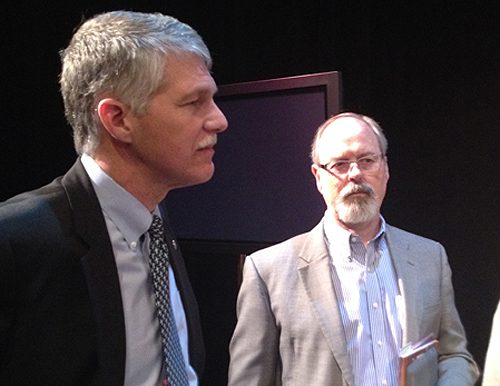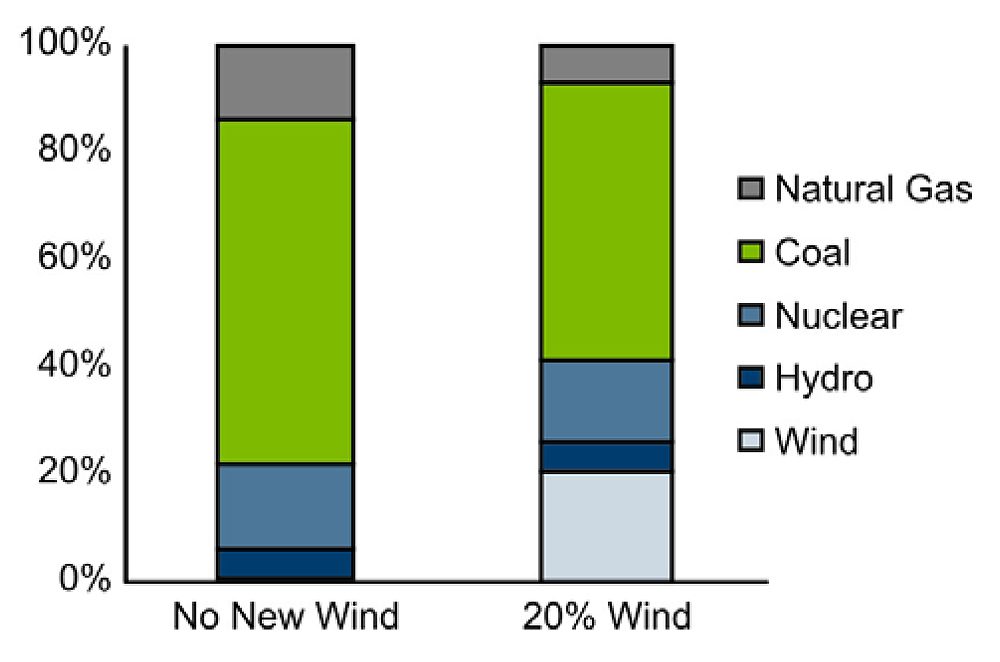
GRAND RAPIDS, Mich. – Tom Kiernan, CEO of the American Wind Energy Association, put it bluntly. “I believe the work we do in the next 10 years will change life on earth. Our children, the future of the environment, of wildlife, depend on what we do.”

Kiernan was in Grand Rapids April 24 at Aquinas College, presenting the case on wind energy for the Wege Foundation’s Economicology event “How Wind Energy can Power a Cleaner, Stronger America.”
The auditorium, which included Grand Rapids Mayor George Heartwell, was filled for the annual environmental event. Since 1997, the Wege Foundation has invited scientists, authors and thinkers to present a free public lecture on environmental issues and their connection to healthy economies and communities.
Kiernan emphasized five main issues to meet a national goal of 20 percent use of wind energy in the U.S. energy mix by 2030.
He stressed the “extraordinary importance” of working on climate change on many levels –personal, local, state and federal. Michigan is playing a leadership role and can do more to demonstrate the importance of renewable energy, he said.
To support his call for wind energy and clean energy, Kiernan cited three reports on climate change, including a recent IPCC fifth assessment report that had these key findings:
• global temperatures are rising;
• sea levels are rising;
• rainfall patterns are changing;
• extreme weather events are increasing;
• and carbon emission in the past decade are growing faster than any preceding decade.

But the Intergovernmental Panel on Climate Change (IPCC) assessment also said the challenges can be addressed and the emissions can be mitigated with negligible impacts on the economy, he said.
Kiernan also cited findings by the American Association for the Advancement of Science, which he said stated, “We are already feeling effects of climate change. The ultimate consequences could be catastrophic and that the window for effective action is quickly closing.”
The third report he referenced was from the World Economic Forum on the top 10 economic risks facing the world.
“In summary, climate change will dramatically harm life on earth, and solving it will not harm the long-term economy of either this country or others. It’s a no brainer for my perspective moving forward.”
The commitment to reducing greenhouse gases needs to be personal and it needs to be positive, he said.
Where we are with wind energy
1. Wind energy has grown more efficient and less expensive over the past several decades. The cost of wind energy has dropped 90 percent in the past 15 years. Wind generator size has grown from 20 meters to 100 meters.
2. Wind energy worldwide has seen a 10-fold growth in the past 10 years. Leaders in the industry have changed, now with China as the world leader and the U.S. as second.
“This matters because the companies – whether it’s GE, Siemens that are developing turbines or others – and investors will go where the market is. Those companies are moving their plants, their technology, their workers. The industry is clean, high tech. We want it. We want to be the leader.”
3. Wind farms in U.S number about 900, with another 100 under construction. They produce roughly 60,000 megawatts in total, or the equivalent power for 15 million homes in the U.S. That represents 4.4 percent of all electric generation in the U.S.

“We are on track with a DOE study – Wind Vision – to get to 20 percent by 2030.
These wind farms also generate $180 million in lease payments for the owners of the land they sit on, he added. “Farmers and ranchers are some of best advocates. They say ‘It’s the best drought resistant crop we’ve ever had.’”
“The takeaway is that we are creating a new industry in this country. It’s exciting and it is exploding and growing in a very positive way. Every single state has either a wind farm or a manufacturing facility.
“When you look at new energy added to the grid over the past five years, 31 percent has been from wind energy; 39 percent has been natural gas. We are quite proud of the fact that a full third is from wind.” Interestingly, Texas is the No. 1 wind power generator.
In Michigan
In the past two years, Michigan has tripled the amount of wind energy on the grid. From over 300 megawatts to over 900 megawatts. The state has $2.3 billion invested in wind energy.
“Because of that investment, the manufacturing facilities, the efficiency that I mentioned, wind is now the cheapest form of electricity in Michigan.”
“You have 40 manufacturing facilities in Michigan involved in wind energy,” he said. “I cannot think of a better case. You are at the cutting edge.”
The policies
One big problem with federal policies is the instability of the Production Tax Credit, Kiernan and others said at the event. The PTC is the main support and incentive for the wind energy industry, but it is on a year-by-year basis. “It’s on again and off again. And that is a problem. Boom and bust is no way to run a railroad.”
 In 2013, for example, there was 92 percent drop in wind energy development and production because of uncertainty at the end of 2012 over the extension of the PTC, Kiernan said. However, the message may be getting across at the federal level, he added, with a possible extension of PTCs through 2015 being considered.
In 2013, for example, there was 92 percent drop in wind energy development and production because of uncertainty at the end of 2012 over the extension of the PTC, Kiernan said. However, the message may be getting across at the federal level, he added, with a possible extension of PTCs through 2015 being considered.
The stability of economic incentives hit home for David Slikkers, principal at Energetx Composites in Holland, Mich. Energetx makes the big blades used by wind turbines and blades for tidal turbines, among other products.
“I am advocating stability in the PTC environment. It fosters growth in the industry, economy and jobs.”
Energetx Composites was founded in 2008 and Slikkers said the company is in good shape and growing. “We are quoting more projects than ever before,” he said.
Corp! magazine covered Energetx Composites in a story in 2010, read it at http://www.corpmagazine.com/features/cover-stories/boats-and-blades-composites-link-two-industries/

The second policy impacting the industry is the Renewable Portfolio Standards (RPS), which legally mandate a percentage of energy supply from renewable sources.
Michigan’s RPS, signed into law in 2008, requires Michigan electric providers to achieve a retail supply portfolio that includes at least 10 percent renewable energy by 2015.
“We need to defend and strengthen, if possible, the RPS in states nationwide. 29 states have Renewable Portfolio Standards. Getting a tough rule that gives flexible policy for states is what we need.”
Opposing views
Kiernan’s speech drew criticism even before the April 24 event. Kevon Martis, director of the Interstate Informed Citizen’s Coalition, testified in support of repealing renewable energy mandates in Michigan in March 2014.
Martis posted these comments and a link to his testimony on the M/Live news site story by Joanne Bailey featuring the upcoming speech.
“There is so much this fossil-fueled lobbyist leaves out of his presentations I have found it easier to rebut with this video: https://www.youtube.com/watch?v=W1VLIQJsaos.
“Most importantly he ignores two things:
1. Mandating that MI apply only renewable energy generated in MI to the percentage mandate is unconstitutional.
2. MI wind is grossly uncompetitive with our regional peers like IA and MN. Post subsidies MI pays $79/MWh for wind energy that can be purchased from IA for $30/MWh. There is nothing but regional disadvantage for MI to try and force more wind into our portfolio when we have an anemic wind resource.”
Wind farm siting issues
Kiernan acknowledged that there are issues with the locations of wind farms.

“Wind farms do not belong everywhere. We need to let science be our guide. We need a public process that lets homeowners clearly have a viewpoint. We need to address the real siting issues.”
Kiernan, who previously had spent 15 years as president of the National Parks Conservation Association, said his colleagues there told him not to put wind farms near national parks. “I totally agreed with that.”
Another topic was brought up by an audience member about the danger to migratory birds from the turbine blades. While there have been many reports about wind energy and migratory bird deaths, Kiernan emphasized that less than 1 percent of human-caused bird deaths are from wind farms.
Where we go from here
In wrapping up his comments Kiernan cited the following points:
1. The future is now. It is time to address greenhouse gas emissions and global warming. It is not too late to make effective changes. These changes will not have a detrimental effect on the economy. “We have a 10-year window to make a difference.”
 The declining cost of wind energy makes it great choice, he said. Because of more industry manufacturing, technology and efficient applications, the cost of wind energy production has dropped 90 percent since 1980.
The declining cost of wind energy makes it great choice, he said. Because of more industry manufacturing, technology and efficient applications, the cost of wind energy production has dropped 90 percent since 1980.
2. Collaboration. Efforts to reduce greenhouse gases and incorporate increased renewable energy sources in the mix will take the work of many groups, from the Healing Our Waters Coalition to the CAA 111D (Clean Air Act) to religious groups. “We have to do a better job of collaboration.”
3. Make it personal and positive. It has to be relevant to daily life. Michigan has had great success with its Renewable Portfolio Standard, he said, and should make a goal of 30 percent by 2030. “Michigan is on the front line, the cutting edge. Moving forward with renewables makes sense. Michigan can help demonstrate to Congress the need to increase renewable energy.”
4. National policies. Kiernan urged the audience to be an advocate for stable Production Tax Credits and leveling the playing field for fuel subsidies. “Upcoming elections in November are extremely important.”
“We need to be heroes. We have the technology. It is here and now and proven. We just need the policies to roll it out,” Kiernan said. “Electric energy is the No. 1 source of carbon emissions contributed from the United States. We cannot move forward with reducing carbon emissions as a nation, unless we get the electric generating sector to reduce its emissions.
About the address venue: Wege Foundation founder Peter Wege started the speaker series in 1997 to highlight his Economicology philosophy. In the 1990s, Wege coined the word “economicology” to define the balance the world must find between “economics” and “ecology.” His father, Peter Martin Wege, founded Metal Office Furniture in 1912, which is today’s Steelcase Inc., the largest office furniture maker in the world.








